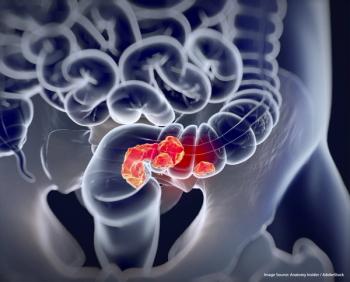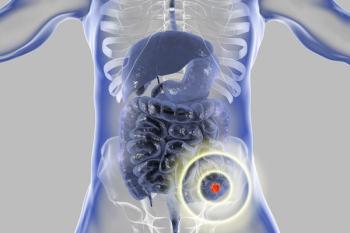
Oncology NEWS International
- Oncology NEWS International Vol 14 No 10
- Volume 14
- Issue 10
SLNM May Reduce Colon Ca Recurrences by Upstaging Patients Who May Then Receive Adjuvant Chemotherapy
ORLANDO-Sentinel lymph node mapping (SLNM) upstaged nodal metastases in 15% of colon cancer patients in a single-institution retrospective study of more than 300 colon cancer patients at stages T1 to T4. Routine pathological examination after conventional surgery understages 15% to 20% of colorectal cancer patients, the researchers said. Thus, SLNM has a potential survival benefit: "Higher numbers of patients with nodal metastases in the group that underwent SLNM went on to receive chemotherapy," they reported. "This may explain the reduced recurrence rates seen in these patients, which may lead to prolonged survival."
ORLANDO-Sentinel lymph node mapping (SLNM) upstaged nodal metastases in 15% of colon cancer patients in a single-institution retrospective study of more than 300 colon cancer patients at stages T1 to T4. Routine pathological examination after conventional surgery understages 15% to 20% of colorectal cancer patients, the researchers said. Thus, SLNM has a potential survival benefit: "Higher numbers of patients with nodal metastases in the group that underwent SLNM went on to receive chemotherapy," they reported. "This may explain the reduced recurrence rates seen in these patients, which may lead to prolonged survival."
Lead investigator Sukamal Saha, MD, presented the findings in a poster session at the 41st Annual Meeting of the American Society of Clinical Oncology (abstract 3567). Dr. Saha, of McLaren Regional Medical Center and Michigan State University, Flint, noted striking differences in recurrence, with recurrence rates up to eight times higher in patients managed conventionally, compared with patients who underwent SLNM.
The study included 315 patients with colon cancer treated and followed within the same institution. Investigators retrospectively compared recurrence patterns of patients who underwent either SLNM followed by standard oncologic resection by one oncologic surgeon (n = 153) or conventional oncologic resection by six general surgeons (n = 162).
Patients undergoing SLNM were injected with isosulfan blue dye (Lymphazurin 1%) subserosally and circumferentially around the tumor. The first one to four blue nodes identified within the first 5 to 10 minutes of injection were designated as SLNs.
The focused pathological examination of the SLNs comprised multilevel sections at intervals of 10 to 40 microns, with four sections stained for H&E and one section assessed with immunohistochemistry for cytokeratin. Non-SLNs in the SLNM group and all LNs in the conventional surgery group were examined by standard methods with H&E.
All patients were followed by the same group of oncologists (median follow-up, 56 months; minimum follow-up, 29 months). Data were collected for age, number of LNs, tumor and nodal status, and recurrence patterns.
More Node Positives
The average number of LNs studied in the SLNM group was 15.5 vs 11.8 in the conventional surgery group (P = .0001). T-stage distribution in the SLNM and conventional-surgery groups, respectively, was 11.1% vs 8% at stage T1, 22.2% vs 14.2% at T2, 62.1% vs 69.2% at T3, and 4.6% vs 8.6% at T4. SLNM was successful in 100% of patients, with an accuracy of 94.7% and a sensitivity of 89%.
For all T stages, Dr. Saha said, a greater proportion of node-positive patients were identified in the SLNM group (51.6% vs 35.6%, respectively; P = .005).
"SLNM upstaged 15% of patients with micrometastases that would have been missed by conventional methods," Dr. Saha commented. This occurred even though more patients in the SLN group were T1/T2 (51 vs 36). The most striking difference observed was in T3 patients, 67.3% of whom were node positive in the SLNM group vs 42% in the conventional-surgery group (P = .0004).
Fewer Recurrences With SLNM
The recurrence rate was significantly greater for both node-positive and node-negative patients managed with conventional surgery (24.6% vs 7.1% with SLNM). Among node-positive patients, an 11.3% recurrence rate was observed with SLNM vs 36.8% with conventional surgery (P = .0004). Among node-negative patients, the recurrence rate was 2.7% for SLNM vs 18% for conventional surgery (P = .0025).
For stage I (T1, T2, N0) patients, recurrence in the SLNM and conventional-surgery groups, respectively, was 1.96% vs 11.1% (P = .002). All four recurrences in the conventional group occurred in N0 patients, "suggesting that there were possible missed and therefore untreated micrometastases, and perhaps explaining the overall increased incidence of recurrence in the conventional-surgery group vs the SLNM group," Dr. Saha told ONI. He concluded, "SLNM is simple and accurate in determining nodal metastases. Compared with conventional surgery, it upstages a significant number of patients whose disease may remain undetected by conventional methods. Patients upstaged by SLNM could receive adjuvant chemotherapy, resulting in a further decrease in recurrence and perhaps prolonged survival."
Articles in this issue
about 20 years ago
EUS-FNA + Mediastinoscopy Boosts Staging in NSCLCabout 20 years ago
Digital Mammography More Accurate in Younger Womenabout 20 years ago
Taxotere/Herceptin Ups DFS in Early-Stage HER2+ Breast Caabout 20 years ago
FOLFOX4 + Avastin Ups Survival in Colorectal CaNewsletter
Stay up to date on recent advances in the multidisciplinary approach to cancer.





